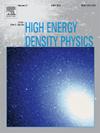Observation of laser-driven and shock-driven preheat effects on 3D-printed, two-photon polymerization plastic lattices
IF 0.9
3区 物理与天体物理
Q3 PHYSICS, FLUIDS & PLASMAS
引用次数: 0
Abstract
Los Alamos National Laboratory’s Bosque campaign on the National Ignition Facility (NIF) seeks to understand how the mix of shell materials and fusion reactants effects the deuterium-tritium (DT) fusion rate in an inertially confined fusion capsule. The NIF platform uses deuterium in a plastic, 3D-printed, two-photon polymerization (2PP) lattice inside the capsule. The voids between the matrix of lattices is filled by tritium gas. Preheat expands the individual lattice struts, which causes deuterium and tritium to prematurely mix before the capsule converges. This preheat is assumed to be created by either laser plasma interactions (LPI) or radiation from the shock. Capsule initial conditions are sensitive to sources of preheat, which necessitates a comprehensive study of how preheat interacts with the lattice.
In this work, results from a shock-tube campaign conducted on the Omega Laser Facility to study the impacts of preheat on a 2PP, 3D-printed lattice is discussed. In these experiments, OMEGA 60 laser beams directly irradiated a plastic ablator (I W/cm), which created both a source of hot-electrons and a radiative shock to preheat the lattice. Expansion of a witness disk is radiographically imaged due to the small size of the lattice struts. We attempted to isolate the preheat source to only the radiative shock by including a thin-gold foil in select ablators to mitigated hot-electron preheat. However, we found that the gold layer reduced the shock speed in the lattice from a plastic only case of m/ns to /ns. The gold layer is estimated to dramatically reduce the radiative preheat due to slowing of the shock, while the hot electron energy is only mildly reduced. Measurements of the witness disk expansion were likely scattered due to the nearby lattice having a similar average areal density to that of the edge of the witness disk. The uncertainties of these measurements are large and more experimental measurements with target design changes are needed to clarify the impacts of preheat on the lattice expansion.
激光驱动和冲击驱动对3d打印双光子聚合塑料晶格的预热效果观察
洛斯阿拉莫斯国家实验室在国家点火装置(NIF)上的博斯克运动旨在了解壳材料和聚变反应物的混合如何影响惯性约束聚变胶囊中氘-氚(DT)的聚变速率。NIF平台在胶囊内的塑料、3d打印、双光子聚合(2PP)晶格中使用氘。晶格矩阵之间的空隙被氚气体填充。预热会使单个晶格杆膨胀,导致氘和氚在胶囊会聚之前过早混合。这种预热被认为是由激光等离子体相互作用(LPI)或冲击辐射产生的。胶囊初始条件对预热源很敏感,这就需要对预热如何与晶格相互作用进行全面的研究。在这项工作中,讨论了在Omega激光设备上进行的激波管运动的结果,该运动研究了预热对2PP 3d打印晶格的影响。在这些实验中,OMEGA 60激光束直接照射塑料烧蚀器(I ~ 8×1014 W/cm2),产生热电子源和辐射冲击来预热晶格。由于晶格支撑的小尺寸,见证盘的膨胀是射线成像的。我们试图通过在选定的烧蚀器中加入薄金箔来减轻热电子预热,从而将预热源仅隔离为辐射冲击。然而,我们发现金层将晶格中的冲击速度从仅塑料的86.0μm/ns降低到51.2μm/ns。据估计,由于冲击的减缓,金层大大降低了辐射预热,而热电子能量只是轻微降低。由于附近的晶格具有与见证盘边缘相似的平均面密度,因此对见证盘膨胀的测量可能是分散的。这些测量结果的不确定性很大,需要更多的实验测量和目标设计的变化来阐明预热对晶格膨胀的影响。
本文章由计算机程序翻译,如有差异,请以英文原文为准。
求助全文
约1分钟内获得全文
求助全文
来源期刊

High Energy Density Physics
PHYSICS, FLUIDS & PLASMAS-
CiteScore
4.20
自引率
6.20%
发文量
13
审稿时长
6-12 weeks
期刊介绍:
High Energy Density Physics is an international journal covering original experimental and related theoretical work studying the physics of matter and radiation under extreme conditions. ''High energy density'' is understood to be an energy density exceeding about 1011 J/m3. The editors and the publisher are committed to provide this fast-growing community with a dedicated high quality channel to distribute their original findings.
Papers suitable for publication in this journal cover topics in both the warm and hot dense matter regimes, such as laboratory studies relevant to non-LTE kinetics at extreme conditions, planetary interiors, astrophysical phenomena, inertial fusion and includes studies of, for example, material properties and both stable and unstable hydrodynamics. Developments in associated theoretical areas, for example the modelling of strongly coupled, partially degenerate and relativistic plasmas, are also covered.
 求助内容:
求助内容: 应助结果提醒方式:
应助结果提醒方式:


